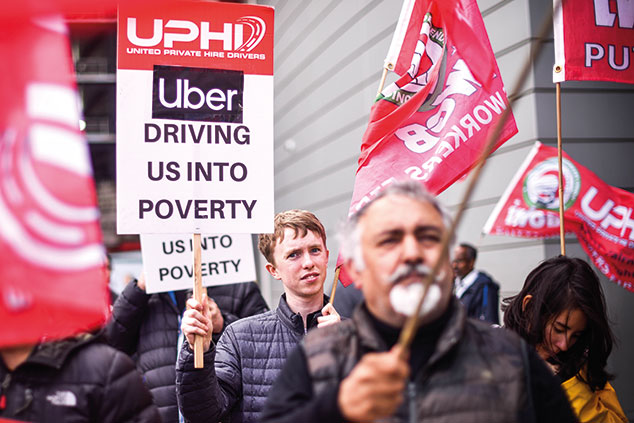
What’s happened?
The ride-hailing app Uber has got off to a sputtering start in its new guise as a publicly listed company. But perhaps that should come as no surprise. Uber has never made a profit, lost $3bn last year, and warned prospective shareholders in its prospectus of the regulatory risk associated with the company. Nor would potential investors have been thrilled by the strike by Uber and Lyft drivers in several cities just days before the initial public offering (IPO).
What was the strike about?
Drivers cited several reasons for the action, including safety concerns, a lack of transparency over how wages are calculated, and decisions about “deactivating” (sacking) drivers. But the big and overriding issue is low and falling pay. According to a US study last year, the average Uber driver makes just $11.77 an hour after fees and vehicle expenses.
In the UK, the situation is similar, though there’s disagreement about the true rate after costs. In other words, says Business Insider, the action highlights a “fundamental problem” with Uber’s business model: it is losing vast sums despite paying its drivers low wages. That situation can only intensify as a listed company, under more pressure to deliver a profit – and under more pressure from drivers to pay a fair wage. Meanwhile, in many countries and cities Uber is under pressure to clarify or regularise the employment status of its drivers.
How is it unclear?
Uber is the poster boy for the so-called gig economy – Uber and similar firms argue that they simply link up willing drivers with willing customers, but don’t actually employ workers. That means the low levels of pay for the workers are in fact even lower than they seem (since they don’t get any of the benefits of employment, such as employer oversight of safety, paid holidays or contributions to pensions and so on).
There’s a big upside for the workers, of course – they have flexible hours, and can choose to work when and where they want. For many, Uber driving is a part-time or extra job, or a fill-in between more regular work. Several studies have found that drivers only tend to stay in the Uber “gig” for between three and six months on average. Ominously, the Uber prospectus concedes that being forced to reclassify drivers as employees would have a big impact on its financial sustainability.
Will that happen?
In the US, Uber faces multiple legal battles (and last week set aside up to $170m to settle one dispute involving tens of thousands of drivers who claimed they had been misclassified). Changes are coming in several key jurisdictions. Last month the EU approved new rules, which will come into force within three years, giving more employment rights to independent contractors in “atypical contracts and in non-standard jobs”. These include compensation for cancelled jobs and the right to more regular hours.
What about in Britain?
Similar legislation was announced last December, based on the recommendations of policy adviser Matthew Taylor, who argues for a new category of “dependent contractor”. Britain is one of many countries where Uber is locked in legal battles over the issue.
In December it lost an appeal against a landmark employment tribunal ruling that drivers must be classed as “workers” with access to the minimum wage, paid holidays and various employment protections. The appeal court judges found that, given the degree of control Uber exerts over its drivers, there was a “high degree of fiction” in Uber’s stance that its drivers are merely subcontractors. Uber was given leave to appeal to the Supreme Court and its decision could affect tens of thousands of gig workers.
How big is the gig economy?
Even if you define the gig economy fairly narrowly as the sector in which short-term jobs are assigned via online platforms, estimates vary between 1%-5% of workers. As is the case with zero-hours contracts, gigging obviously brings important benefits to some individuals who prize flexibility. And the advantages to consumers are also clear.
But from a legal and moral standpoint, it cannot be right, reckons The Economist, that firms such as Uber “specify how workers must submit to the duties of acting like employees even as they reject the responsibilities of acting like employers”. If the courts rule that gig workers are employees, that will raise costs and risk killing innovation and jobs.
But inaction brings risks, too. If a growing proportion of the workforce has to make do with poor pay and worse pensions, “governments will eventually have to pick up the pieces”.
Isn’t there a role for unions here?
Indeed, and a deal struck by a British trade union near the start of this year looks promising, says Sarah O’Connor in the FT. The victories in the courts have so far changed little on the ground as companies appeal the rulings.
The GMB union has instead negotiated a deal directly with the employer (in this case, delivery company Hermes). The company’s 15,000 couriers can now choose to remain self-employed or opt for a new “self-employed plus” status, which offers union representation, minimum-wage guarantees and holiday pay.
This raised eyebrows – should a union be encouraging a deal whereby workers can opt out of employment rights a court has already said are owed? But it should prove to be a “beachhead” from which to establish collective bargaining and push for better conditions in future.
Another trade union, Community, has a different solution – it has launched its own app, Labour Xchange, which links people with employers who need temporary workers. Workers are guaranteed multiple safeguards, including that they will be paid at least the living wage and that businesses that repeatedly book individual workers must offer them a contract.